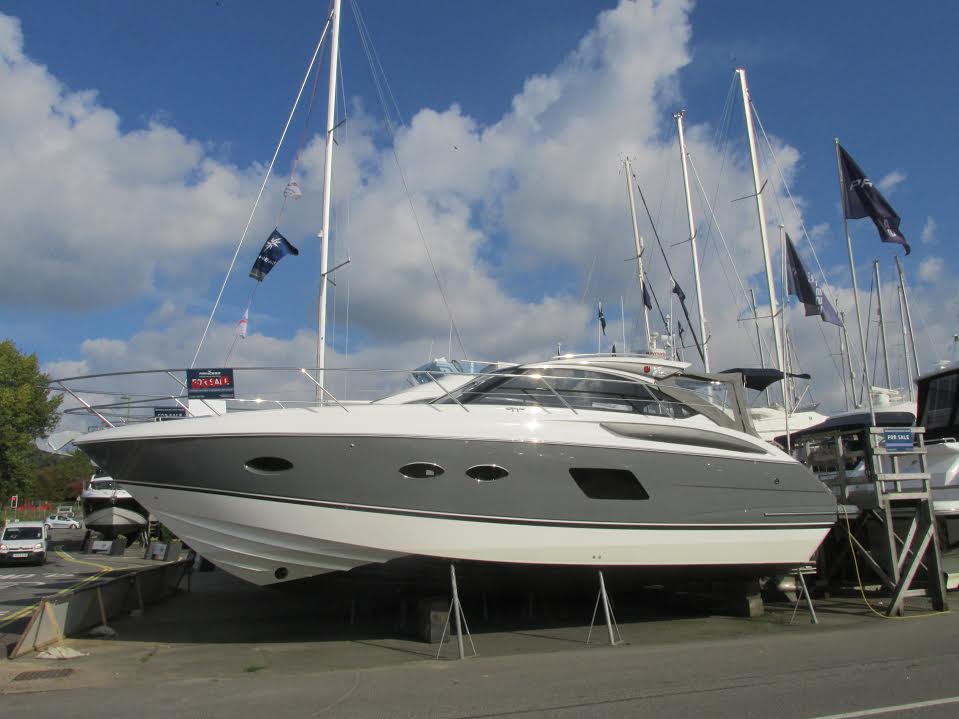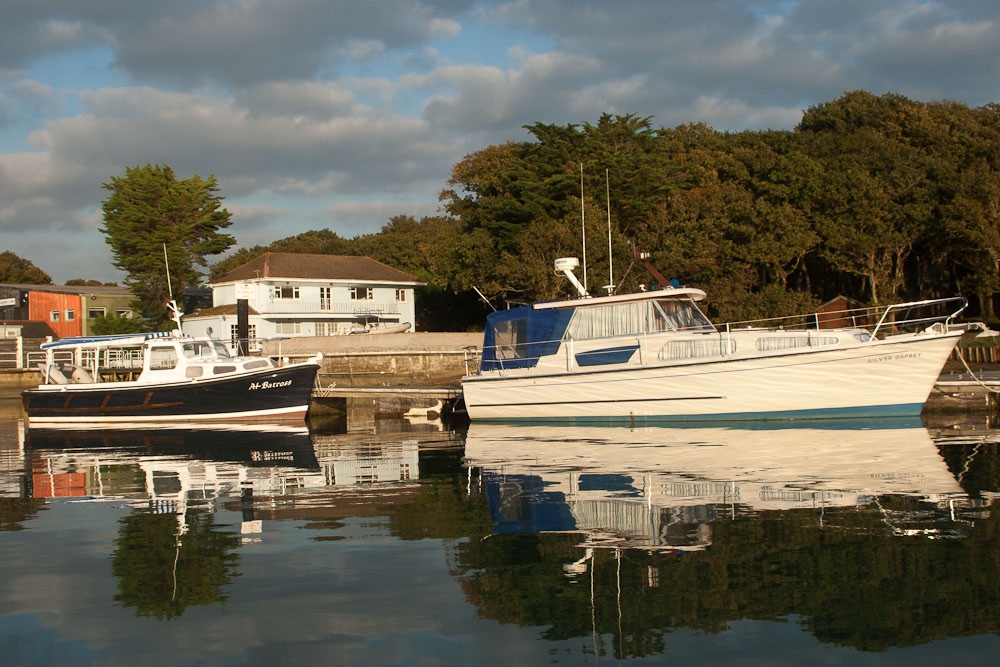There are plenty of reasons why someone decides it's time to sell their current boat. Most boat owners are looking to move on to something new, more often larger than before, or a boat that suits the family better. For others, it can be less of a happy occasion, forced to sell due to unforeseen circumstances, for example. Whatever the reason, it is crucial that it’s done properly.
We have decades of experience in assisting online boat sales and have created this guide from our expertise to ensure a fast and easy exchange for all. This guide breaks down the selling journey into the following seven core sections. Click on the link below that describes where you are in the process to prepare for your next step.
Broker or no broker?
Selling privately
Pros
- You take away all of the profit.
- Fewer people involved can mean a quicker sale.
- You control how your boat is sold.
- You know your boat best.
- It will take up a lot of your time.
- It can be a big learning curve. You will have to get to know the boat market as well as the ins and outs of selling a boat (sea trials, surveys, etc.).
- You will have to do all the paperwork
Using a broker
Pros
- They will handle all paperwork and legal matters.
- They will help value your boat properly.
- They are experts in sea trials, surveys and other parts of the process.
- You get less profit as brokers usually charge a 10% commission.
- You can’t control how your boat is sold.
- It can be a longer process as there are more people involved.
Preparing your boat for sale
Before you can think about selling your boat, you need to prepare your boat correctly for sale. Unless you are selling a project boat, the condition should be brought up to the level you would also be impressed by as the auspicious buyer.Turn-key ready
If you're serious about selling your boat and there are any mechanical issues or parts that need replacing, do it straight away. It is always worth the investment to right any wrongs as soon as you can. Issues will be found eventually in the survey and sea trial. Suppose something relatively obvious is detected. In that case, this will rightly put off potential buyers from doing business with you. It could cost you more in the long run for keeping it longer than anticipated or reduce your asking price dramatically.Key areas to revamp:
- Get your engine serviced if it hasn’t already had one in the last year with corresponding papers.
- Replace any rigging or constant-use equipment that is nearing a decade old.
- Make sure your electrics and plumbing are sound. If in doubt, replace.
- Fix any cosmetic issues, both interior and exterior, that could be brought up in a viewing.
- Check additional extras in the sale: trailer, tender, safety equipment and spares.
For more information see:
Squeaky Clean
Boats that look neglected and poorly maintained can be very off-putting for a potential buyer. Many of us are guilty at times of being slack. It isn’t easy, of course. Boat maintenance is time-consuming and not always enjoyable, but it is necessary. You might think you only judge the areas ‘that matter’ and therefore assume most other boat owners think the same, but this is rarely the case. When selling your boat, compare yourself with that meticulous owner in the marina. The one working on their boat obsessively when you leave and come back from a weekend away.
Cleanliness alone can be enough to turn a potential buyer into a new owner. A clean look and feel will let buyers know that everything is in good order and that the boat has been well looked after over the years. Not only this, but it’s the single most cost-effective way of retaining value and receiving the best price for your craft.
Spruce Checklist:
- Sails/cover/canopy/upholstery: Make sure all fabrics have been scrubbed stain-free and have been re-waterproofed.
- Pressure wash, recent antifoul and polish: Any hull can do with this added shiny benefit for a quick sale.
- Refurbish teak decking: Clean softly, repair any damaged caulking or sanding if necessary and apply a protective sealer.
- Spotless stainless steel: All metal should be rust-free and properly washed for a mirror finish.
- Boat show interior: Hoover the inside and thoroughly deep clean – no different to selling a property.
- Engine/engine room needs to impress: Pictures, samples and prying eyes will be looking over this area, so you must wipe away all dirt and residue. If you have an old diesel engine with good access, a degrease, rust remover and fresh paint can have your engine looking brand new.
Anything that needs doing that is out of your remit can be worth its weight in gold by paying a professional to do it. In most cases though, you can do it yourself, which is only more profit in the eventual sale.
Declutter
A listed boat needs to look as un-lived in as possible. Therefore, you should remove all items that are not included in the sale. That’s because it can be difficult for a potential buyer to imagine themselves using the boat with someone else’s belongings in sight.
All too often once the listed boat has had a makeover, the owners might still head out for one last hurrah. Or worse, the children have gone and spent a night onboard while they still can. Just make sure this doesn’t happen the night before a viewing – although it wouldn’t be a first!
Stage
Now that you’ve cleaned and decluttered, it’s time to stage your boat. If you’ve ever had to stage your home for potential buyers, this is essentially the same idea. You want your buyer to feel at home and to imagine themselves owning the boat. Of course, there are always professional boat stagers, but if you do it yourself it will save your hard-earned money! When staging, it’s best to keep to a neutral colour palette, but you can always choose an accent colour to brighten it up. Orange or navy blue are always a good choice.It’s also advisable to buy new to make the boat look as brand new as possible and so there’s no confusion about who gets what in the sale. The furnishings don’t need to be excessive, just enough to make the place look liveable without looking like it’s actually been lived in. If you aren’t very good at interior design, you can either ask someone who is or check the internet and pinterest for some inspiration. Here’s what you’ll want on your checklist:- A few decorative cushions for sofas.
- Set the table with placemats, dishes and wine glasses.
- Make the beds and add a couple of decorative pillows.
- A clean white towel in the ensuites.

When staging, it’s best to keep to a neutral colour palette, but you can always choose an accent colour to brighten it up.
Listing your Boat for Sale
Now that your boat is looking the part and you’re wondering whether or not to keep her, this is precisely the right time to take some photos. It doesn’t matter what you’re selling, it could be a dinghy tender or a 40-metre yacht, you need to display your listing in the best light possible.Photoshoot
When it comes to compiling images and videos for a listing, the more the merrier. Including old pictures and layout plans are a welcomed sight to the viewer, but we always recommend that you take fresh, updated photos alongside these. They need to be in focus, showing every layout area and equipment included in the sale. Listings with videos and plenty of images are much more likely to receive views and enquiries than those with one to three poorly taken photos.
Don’t have a DSLR camera or similar? Don’t worry! The camera on your smartphone will easily do the job. When taking photos with your phone, make sure the phone is held landscape (horizontal in your hands) and position yourself far back to fit in as much as you can with each photo. If you are taking pictures of the interior, push yourself right up against the side to best capture the space.

Listings with videos and plenty of images are much more likely to receive views and enquiries than those with 1-3 poorly taken photos.
Choosing the right day and time to take pictures helps too. The weather doesn’t apply as much if you are selling a small fishing boat or RIB trailer on your driveway. Just make sure that the photos are coming out clear – so not too dark or bright. For those selling a boat with cabin space, however, pick a nice sunny day. All of your elbow grease and hard work in the previous section can’t be let down by lazy, dark and dingy cabin photos. Start snapping when the sun is shining at the right angle through the portholes, filling your boat with beams of natural light. Sometimes this might be on a crisp morning or late afternoon. You know when you enjoyed being on your boat most, capture those times and sell the dream.
If you can, launching the boat out on the water for some pictures is vital too. Find a nice quiet anchorage, away from the marina and distractions. Hop in the tender and take some attention-grabbing photos or drone footage if you have one. To go the extra mile, filming your boat under sail or steam is an excellent way of genuinely showing how she moves through the water.
Price Point
Setting the right price is perhaps the most crucial part of your boat listing. Of course, we would all like to get a fair, lucky price for our pride and joy, but it’s essential to remain realistic and avoid emotions swaying you on this decision. The price for many used boats for sale can be a complicated answer to work out. More often than not, the seller isn’t going to like the correct answer, but it’s important to remember these are boats, not property or antique works of art, no matter how much blood, sweat and money has gone into it. What is essential to consider is the potential speed of sale and ongoing costs you incur the longer the boat is in your possession. If you are happy to keep using, maintaining and updating your craft until it is sold, then the costs are at least weighed against your enjoyment of still getting out on the water regularly.
For some boat owners, these same costs are ticking over, but they’re unable to use their boat anymore. When there's no interest, this can be a terrible position to find yourself. The other issue with an inactive boat is that it’s not kind to the boat. Lying idle is damaging to engines, electronics and all manner of parts, all the while she most likely isn’t getting as much care and regular servicing as is needed. This is where the low engine hours might be appealing on paper, but the other side to that story is very displeasing.
But don’t despair, as we pride ourselves on helping boaters to get out of this predicament effectively. Follow this guide, make use of our advertising, be realistic, be proactive, and all will be fine.

You can do everything right in this guide, but the price could be what’s stopping your boat from being sold.
A good starting point to gauge the market if you’re unsure how to price your boat is to browse similar models for sale. Find those that are equal in length class, commission year and specification. We also have selling price data available in our Guide Price Tool where you can see other boats that have been listed and sold. If your boat model is not available, or not sold in a recent enough year, try a Google search for your particular boat model. The results might bring up archived listings that have already sold in the past. Be wary of trawling similar boat listings that are still active and don’t let this inflate your estimation. There are a plethora of overestimated boats online. The boats that aren’t overpriced are no longer there to see, keep this in mind.
 All that's left to do now is to cancel your insurance and remove the advertising. And, perhaps most importantly, start the search for your next boat!
All that's left to do now is to cancel your insurance and remove the advertising. And, perhaps most importantly, start the search for your next boat!
Use this browsing exercise as a guide, you will eventually notice the price difference of listings that don’t hang around compared with boats that stay on our site, and other boat marketplaces, for some years. Quite often, there isn’t much in it. Especially if you’re looking to upgrade to a newer or larger boat, as mentioned, that slight drop in asking price might end up saving you money in the long run and leave you with more to spend on your next venture.
The arrangement of the seller’s circumstances, the location of the boat and the type of boat, will all have an impact on the price and how firm the seller might be on their asking price.
Despite this, we would always recommend being open to offers and allowing a margin for these enquiries. It can make or break the sale if you advertise at the mid-to-low or further towards the higher end of your asking margin. You have less to lose advertising at the lower end, preventing potential from buyers being deterred and losing out on the right buyer who has gone elsewhere. You can do everything right in this guide, but the price could be what’s stopping your boat from being sold.
If you would like some further valuation advice, seek out your local broker or surveyor for a valuation survey. You can also get a second opinion by posting a query on our Facebook group or forums to make sure you’re in the right range.
But what makes a good listing?
Title - All titles should include the manufacturer and model type. If you are selling an unknown make or canal boat, you can put the name of the boat and the type or length.
Description - The headline sentences will be formatted in a bold font and are the main strapline for what you are selling. Keep this snappy and cherry-pick the most impressive details in a nutshell. Follow this with a paragraph detailing the specifications and history of the boat. Start from the beginning of your knowledge and include everything you would want to know or wish you had known when you were buying the boat. Cover all recent work, additions, engine hours and any other factors that should shed light on the boat’s condition.
Extra comments - If you wish, writing an extra ‘owner’s comments’ section can help your boat sell. You can write about what you have done on your boat, where you have gone during your ownership and the reason you are selling. Include extra insights that couldn’t be included in a one-day boat test article. Giving a frank and personal account of what you loved most about the boat, and perhaps what you weren’t so keen on, builds a lot of trust between you and the interested buyer. These pockets of knowledge help turn slightly interested parties into those that will want to get in touch right away, so it’s worth considering.
Specification - List everything included in the sale and mention the details of any recent servicing. Include receipts or evidence along with the dates of any newly installed equipment. To show up in the listings when people filter their searches, you need to also fill out as many of the spec boxes as you can. Even if it seems obvious, or you have already mentioned it, fill out all boxes that apply, from the hull material, draft, steering and so on, to the best of your knowledge.
Platforms
When listing your boat, it’s important to consider different platforms. The more platforms you place it on, the more exposure it will get. But be sure that you choose them carefully. Here are some of the places where you can list your boat:
- BoatsandOutboards.co.uk
- Boatshop24.co.uk
- Facebook Marketplace
- eBay
- iNautia.com
- Boats.com
- YachtWorld.co.uk
Advertising
One of the best ways to sell your boat is by doing it yourself online. This way, you have full control. All enquiries come to you personally and developments in the sale can move quickly at the pace that suits you. Over the decades, we have assisted thousands of boaters to sell and buy all things marine. Take a look at some of our testimonials to hear what our community has had to say.
Placing an ad on our website is easy. After you’ve done it once and seen how it looks, you can go back and add more information and media to refine your listing. Once you’ve finished, sit back and watch the enquiries come flooding in.
If you have placed a free ad with us, have followed our best practices and have not received the level of interest you had hoped, some paid options will put you in front of serious buyers. We also offer a host of other advertising solutions for our business customers. If you would like to find out more, click here.
Responding to Enquiries
Hopefully, at this stage, your ad is managing to attract interest. But perhaps you’re not seeing any serious contenders yet. If that’s the case, it’s important to keep vigilant and organised when communicating with enquirers so that you don’t miss out on any opportunities. You can usually identify a serious buyer by their detailed questions about the inner workings and condition of your boat. There are also some questions that buyers often ask that you should prepare for, such as:- What’s the condition of the boat like? Honesty is key; don’t try and lie about your boat’s condition as it will always come up in the viewing. While you will naturally want to focus on the positives, highlighting your boat’s best assets, you must also reveal any major defects.
- Can I see more photos? Make sure you have extra photos that aren’t on the listing to hand too. The more pictures you have, the better.
- How many owners has it had? Make sure you have all the paperwork handy in case of questions like this.
- How many hours does the engine have? This should be posted in the listing, but some buyers still like to ask.
Beware of Scammers & Time-wasters
It’s not only boat buyers that need to be wary of scammers online, but there are fraudulent people out there looking to take advantage of sellers too. For this reason, you shouldn’t give away any precious information over the phone or online for anything. Read how to spot scam adverts and accounts on our blog.
Time-wasters, on the other hand, are harder to discern. To keep track of who is who, making a note of each enquirer can help. Make time for everyone, especially those that are keen to set up a meeting or a phone call to organise a viewing. If they are not interested in either, you know to focus on someone else.
A seasoned seller can usually pick out a serious buyer quite easily. These potential buyers will ask for more specific information about the boat and its condition, systems and ownership history. Suppose you have constructed a defined advert, as described in the previous section. In that case, the queries should be more specific and prevent you from being bombarded with messages asking for more photos and basic dimensions. Despite this, people will have skimmed your advert and serious buyers will still ask to make sure. If you don’t know every detail by heart, being organised with a spec highlight sheet can make it easier for you to get back to people quickly.
Encourage a survey
When speaking with potential buyers, always be honest, give as much information about the boat as possible and show confidence. This will encourage surveys and sea trials. Be polite and professional and make sure that you ask some questions too. Ask about their deal-breakers and how and where they wish to use their next boat. Knowing popular reasons why people are looking at boats like yours can give you ideas for extra benefits to add to your listing.
Well before your viewing make sure the boat is in order and running fine, so there are no nasty surprises on the day.
Preparing for viewings
Well before your viewing make sure the boat is in order and running fine, so there are no nasty surprises on the day. Be prepared for what people might ask, anticipate offers and concerns and remember what you found out about the potential buyer so you can tailor the viewing to them. If you have taken your boat out on the water since cleaning and staging it, then you might want to revisit those steps to make sure your boat looks the part on the day of the viewing.Paperwork
Make sure you have all relevant paperwork with you as evidence so you don’t stall a possible sale. These documents should include the bill of sale for proof of ownership and registration, RCD or BSS certificate, if applicable, and any warranty or maintenance records and invoices you have.Surveys and Sea Trials
After an initial viewing, the buyer, in most cases, will want a professional opinion to back up their offer. The surveyor will produce a full pre-purchase survey on the condition of the vessel and a sea trial, which is where the buyer can see how she handles, and an engineer might run some tests on the engine and mechanics out on the water. The price for this is usually (but not always) covered by the buyer.
To prevent your time from being wasted by someone not serious enough, the seller can make a deposit. Usually, the cost of launching, lifting, fuel, and an accompanying captain is paid for by the buyer with a deposit, which is roughly 10% of the asking price agreed in writing. The deposit can be claimed back if there is anything wrong or unexpected that comes from the survey or sea trial but ensures they’re not merely taking your boat out for a spin. In certain circumstances, this ‘10%’ deposit may not be necessary and the intent from the buyer will be apparent due to the distance they are travelling and the money they are paying for external professionals to assist them.
During the sea trial, show them how she performs around your local waters and let them take the helm, but make sure you are always watchful and on-hand. You are liable for any accident or damage. Depending on the situation, any remedial work needed resulting from the survey and sea trial can be joint-paid for by both parties or adjusted in the price. If all goes well, the final negotiations will take place, but more often than not, the initial agreed offer will still stand, and both parties will be happy to shake hands.
Making the sale
The final stage of processing the sale is all about administrative work. To legally change ownership, the relevant paperwork and forms need to move over to the new owner. Many brokers can help with this process to make sure all documents are in order. It is dependent on the particular situation, boat type, location and so on, but as a rough guide, the document checklist is as follows:- Bill of sale: This should include the boat details, hull ID, price of sale and the signatures of both the seller and buyer. You can find an example from RYA here.
- Registration documents
- Warranty documents
- Maintenance records
- VAT documents: Plus receipts for everything included in the sale
- Mooring documents: Only if applicable


